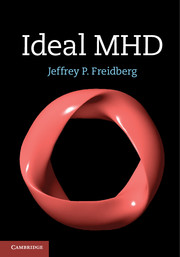Book contents
- Frontmatter
- Dedication
- Contents
- Preface
- Acknowledgements
- 1 Introduction
- 2 The ideal MHD model
- 3 General properties of ideal MHD
- 4 MHD equilibrium: general considerations
- 5 Equilibrium: one-dimensional configurations
- 6 Equilibrium: two-dimensional configurations
- 7 Equilibrium: three-dimensional configurations
- 8 MHD stability – general considerations
- 9 Alternate MHD models
- 10 MHD stability comparison theorems
- 11 Stability: one-dimensional configurations
- 12 Stability: multi-dimensional configurations
- Appendix A Heuristic derivation of the kinetic equation
- Appendix B The Braginskii transport coefficients
- Appendix C Time derivatives in moving plasmas
- Appendix D The curvature vector
- Appendix E Overlap limit of the high β and Greene–Johnson stellarator models
- Appendix F General form for q(ψ)
- Appendix G Natural boundary conditions
- Appendix H Upper and lower bounds on δQKIN
- Index
- References
7 - Equilibrium: three-dimensional configurations
Published online by Cambridge University Press: 05 July 2014
- Frontmatter
- Dedication
- Contents
- Preface
- Acknowledgements
- 1 Introduction
- 2 The ideal MHD model
- 3 General properties of ideal MHD
- 4 MHD equilibrium: general considerations
- 5 Equilibrium: one-dimensional configurations
- 6 Equilibrium: two-dimensional configurations
- 7 Equilibrium: three-dimensional configurations
- 8 MHD stability – general considerations
- 9 Alternate MHD models
- 10 MHD stability comparison theorems
- 11 Stability: one-dimensional configurations
- 12 Stability: multi-dimensional configurations
- Appendix A Heuristic derivation of the kinetic equation
- Appendix B The Braginskii transport coefficients
- Appendix C Time derivatives in moving plasmas
- Appendix D The curvature vector
- Appendix E Overlap limit of the high β and Greene–Johnson stellarator models
- Appendix F General form for q(ψ)
- Appendix G Natural boundary conditions
- Appendix H Upper and lower bounds on δQKIN
- Index
- References
Summary
Introduction
Two-dimensional configurations with toroidal axisymmetry have been investigated in Chapter 6. Many fusion concepts fall into this class – tokamaks of all types, the reversed field pinch, the levitated dipole, the spheromak, and the field reversed configuration. One common feature in each of these concepts is the need for a toroidal current to provide toroidal force balance, either using a perfectly conducting shell or a vertical field.
The need for a toroidal current is of particular importance to the tokamak and RFP, the most advanced of the axisymmetric configurations. The reason is that it is not possible to drive a DC toroidal current indefinitely with a transformer, the method now used in pulsed versions of these configurations. This conflicts with the general consensus that a magnetic fusion reactor must operate as a steady state device for engineering reasons to avoid cyclical thermal and mechanical stresses inherent in a pulsed device. In other words, some form of non-inductive current drive is required. This is an active area of research and while a scientifically sound and technologically viable technique may be possible theoretically, success still depends on current and future experimental development. Overall, non-inductive current drive represents a difficult challenge for the tokamak and RFP concepts.
- Type
- Chapter
- Information
- Ideal MHD , pp. 223 - 326Publisher: Cambridge University PressPrint publication year: 2014



